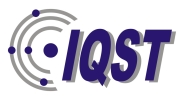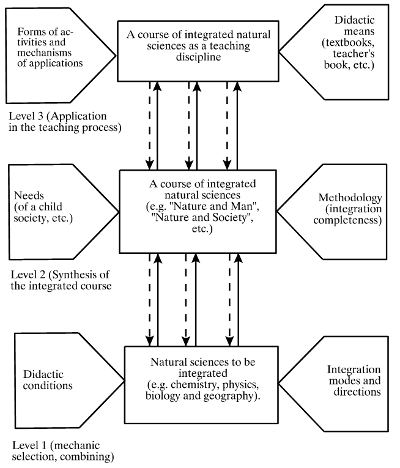The Models of Integrated Science Education
- To meet up with and carefully analyse one of the possible models of integrated science education emphasizing the classification of the subjects taught;
- Define the advantages of integrated science education;
- Understand the levels of integration in science education.
| Information | Nature of activity | Subjects involved |
| Facts |
Prior knowledge
Shared experience
|
Learning about
|
| Concepts |
Processing information
|
Learning through
|
| Generalisations |
Synthesising
|
Learning about
|
| Further information |
Refinement and extension of knowledge
|
- the subjects of content (social sciences, natural sciences, environment sciences, the evolution of personality, technologies);
- the subjects of a process (language, art, drama, mathematics, music, plastics). Integration creates opportunities for learners to investigate, conclude, process information, improve knowledge and impart information on different topics without embarrassment and leaving the barriers of traditional subjects behind. One of the practical arguments for integration, particularly in the middle school years, is that it enhances pupil engagement with school. Several studies show that providing an authentic curriculum, well connected to pupils` needs and interests and to the world outside of school, can result in reduced alienation and increased participation and engagement (Venville, Wallace, Rennie, Malone, 2002).
The process of the integration (in the light of content, forms, activity, etc.) of natural sciences is acclaimed to be very important. We suppose that the model defining the key components of the integration process at every level is possible.
- mechanic selection and combining / the main components are didactic conditions and integration trends and methods /;
- synthesis of the integrated course / the main components are needs and integration methodology (completeness)/;
- application in the teaching process / the main components are activity forms and application mechanisms and the complex of didactic means (textbooks, workbooks, teacher‘s books, extra didactic material, computer programmes, etc. /
A close correlation and interaction exists between these levels. The correlation is not equivalent (level 1 ↔ level 3). The integrated course of natural sciences as a teaching subject, as a matter of fact, is not changed but refreshed and complemented regarding the essential alterations of the educational system. In case of infraction of at least one of the links, integrated teaching will not be effective.
- ways of learning;
- ways of knowing;
- process and thinking skills;
- content knowledge;
- attitudes and perceptions;
- teaching strategies.
- integration of experiences;
- integration of students activities;
- social integration;
- integration of knowledge;
- integration as a curriculum design etc.
- developing cross-curriculum subobjectives within a given curriculum guide;
- developing model lessons that include cross-curricular activities and assessments;
- developing enrichment or enhancement activities with a cross-curricular focus including suggestions for cross-curricular "contacts" following each objective;
- developing assessment activities that are cross-curricular in nature;
- including sample planning wheels in all curriculum guides.
According A.Miller, teachers who use cooperative, integrated methods will produce students more competent in using problem-solving techniques, in communicating effectively and in working cooperatively. Finally, it can be mentioned that at the heart of the interdisciplinary educational philosophy (interdisciplinary science education) is the psychological theory of constructivism.
Tasks (assignments)- Name the advantages of integrated science education:
Subject field Social field
- What is the basis for classifying subjects into two groups presented in the integrated model of science education K. Pigdon and M. Woolley (1993)?
In state X, following the approved educational curriculum developed for comprehensive school, primary school classes are taught a course on the world study covering 2 parts - Social Education and Science Education – which are relatively singled out to underline the problems and links between the topics occurring in every field of education. The course book on this subject freely operates the topics included in both parts and retains notional and subject coherence. In turn, the area of science education consists of 4 components:
- research of nature;
- animate nature (component of biology);
- substances and their variations (component of chemistry);
- physical phenomena (component of physics).
Moreover, science education closely relates not only to social but also to technological-artistic training, mathematics and languages. These subjects either complement one another or make the complete entirety.
- integrated course on sciences Nature and Human including biology, physics, chemistry, earth science, healthy living, ecology, technology and agriculture is taught in forms 5 and 6. The course on sciences is properly integrated considering all subjects taught;
- still maintaining close interdisciplinary relations in forms 7 and 8, biology, chemistry and physics are taught as separate subjects;
- revision courses on biology, chemistry and physics are taught in forms 9 and 10;
- from the point of view of structure, the field of education in forms 11 and 12 consists of 4 subjects:
- biology;
- chemistry;
- physics;
- integrated sciences.
The students choose an appropriate course on sciences – physics, chemistry, biology or integrated sciences. Those who are not intend to study sciences in the future or do not think of any other activity related to sciences but still want to gain more knowledge about this area of study, choose either general courses on separate sciences or the integrated course on sciences. The students interested in carrying on the studies of sciences or those who would like to keep proceeding with this field choose the advanced courses on separate sciences. Although the courses on physics, chemistry and biology are most frequently taught separately in secondary school, these sciences have much in common – concepts and conceptions, methodological principles, solving science and practical issues etc. Thus, a deeper integration of the content of science education is pursued. In addition, the content of science education often relates to the problems of ecology, healthy living, demographical situation and the use of technologies and nature. Plenty of contacts can be noticed between sciences and mathematics.
The integrated course on sciences for secondary school students of forms 11 and 12 focuses on the learners preferring a humanitarian profile and those who are not going to proceed with professional science activities in the future. This course concentrates on modern achievements in science, life experience and environmental problems. All topics are examined in broad outline, the evolution of sciences is discussed as a method of acknowledging nature, the issues of personal and public life are highlighted, natural phenomena and scientific ideas are carefully analysed and observation and experimentation are carried out. The integrated course on sciences is devoted to help the student with pursuing general science education and developing the ability to distinguish between scientific and non-scientific issues as only a sufficiently sophisticated person can be actively involved in solving the problems of a modern country. The course assists the learners in perceiving the significance of sustainable development ideas and protecting biosphere and the quality of public life.
Questions to Case Study- What is the level of integration at every stage of comprehensive school?
- Indicate the observed key components having influence on your position.
There are different models of integrated science education. Teachers can choose suitable model of integration depending on different circumstances. The main circumstances - a level of knowledge of students, presence of accompanying didactic materials, quantity of students in a class, support of administration of school, etc. In a school practice more often as a core of integration three main subjects - chemistry, physics and biology - act. Science teachers can use interdisciplinary integration or integration inside teaching subject. The real problem to teaching integrated science courses is that there are no enough appropriate models or widely-accepted materials available. Integrated science courses gives for teachers a chance to really take a broader look at the nature of science in new ways. It is not the simply teaching. It is obvious that primary goal of integrated science is to teach students how science is done, how to analyze problems and situations, and how to investigate scientific (or pseudo-scientific) claims. Educators and researchers agree that teaching integrated science is a suitable approach for producing scientifically literate citizens. In general, integrated science is a great idea for the students.
Frequently Asked QuestionsIt is evident that integrated science emphasizes organization of learning experiences around a topic/theme. It is likely that this unification of concepts around a theme makes integrated science unique. The learning experiences and concepts of integrated science are organized around the different themes. Organising concepts around common themes is a good way of deliberately removing the subject mater boundaries.
Next ReadingAAAS /Science for all Americans – A Project 2061 Report on Literacy Goals in Science, Mathematics and Technology. (1989). New York: The American Association for the Advancement of Science.
Blum A. (1994). Integrated and General Science. In.: T.Husen, T.N.Postlethwaite (eds.) The International Encyclopedia of Education, Vol.5, P. 2897-2903.
Chepelev N.G. (2003). Authorized course of natural sciences for humanitarian classes of lyceum. In.: Importance of Science Education in the Light of Social and Economic Changes in the Central and East European Countries (The materials of the IV IOSTE symposium for Central and East European Countries). Kursk, p.82-86.
Emelyanova G.M. (2003). The training of a future teacher for integral-modular education realization at school. In.: Importance of Science Education in the Light of Social and Economic Changes in the Central and East European Countries (The materials of the IV IOSTE symposium for Central and East European Countries). Kursk, p. 179-181.
Eurydice Report (2006). Science Teaching in Schools in Europe. Policies and Research. Available on the internet at: http://www.eurydice.org
Jacobs H.H. (1989). The interdisciplinary concept model: theory and practice. Gifted Student Quarterly, Fall.
Palmisano, M., Barron, M., Torp, L. (May 1995). Integrative learning systems: Rationale, overview, and reflections. NCSSSMST Journal, p. 3-8.
Venville, Grady Wallace, John (1998). The Integration of Science, Mathematics and Technology in a Discipline-Based Culture. School Science and Mathematics, October 1998 Vol. 98, Issue 6, pp. 294-303.
ReferencesBerlin, Donna F., White, Arthur L. (1994). The Berlin-White Integrated Science and Mathematics Model. School Science and Mathematics, Vol. 94, No. 1, p. 2-4.
Lamanauskas, V. (2003). Natural Science Education in Contemporary School. Siauliai: Siauliai University Press, p. 514.
Miller, K. A. (1995). Curriculum: To Integrate or Not to Integrate. Youngstown State University.
Palmer, J. (1991). Planning Wheels Turn Curriculum Around. Educational Leadership 49/2, p. 57-60.
Pigdon K., Woolley M. (1993). The Big Picture: Integrating Children’s Learning. Portsmouth: Heinemann.
Venville G., Wallace J., Rennie L., Malone J. (2002). Curriculum integrations: Eroding the high ground of science as a school subject? Studies in Science Education, Vol.37, p. 43.





